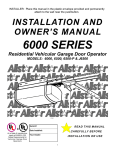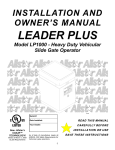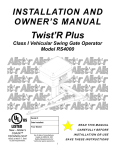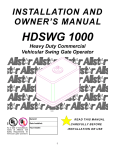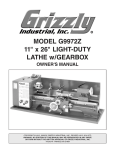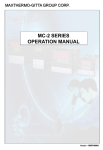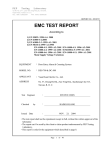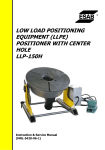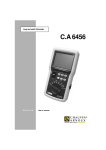Download Allstar ANSI/UL 325 Owner`s manual
Transcript
INSTALLATION AND OWNER’S MANUAL TOWER Medium Duty Vehicular Slide Gate Operator Model RSLG3500 103690 READ THIS MANUAL Serial #: Date Installed: As of date of manufacture, meets all ANSI/UL 325 Safety Requirements for Vehicular gate operators CAREFULLY BEFORE Your Dealer: INSTALLATION OR USE 1 TABLE OF CONTENTS Pre-Installation Notes ........................................ 3 Operator Class Information .............................. 3 Section A: Installation Notes ........................... 4 Section B: Preparing the Site .......................... 6 The Concrete Operator Pad................... 6 Electrical Power Requirements ............. 6 Attaching the Chain Bracket ................. 7 Placing Vehicle Detector Loops ............ 8 Section C: Installing the Operator ................... 9 Placing the Tower Operator .................. 9 Electrical Hookup ................................... 9 Accessory Equipment Hookup ........... 10 Wiring Vehicle Detectors ..................... 11 Wiring Radio Receivers ....................... 11 Wiring Keypad or Telephone Entry..... 11 Wiring Pushbutton/Deluxe Wall Station .......................................... 12 Final Installation Checklist .................. 12 Terminal Strip Reference Chart........... 13 Section D: Starting the Operator 14 Left/Right Hand Installations .................. 14 Mounting the Limit Cams ....................... 15 Presetting the Sensitivity Adjustment ............................................. 16 Pre-Power On Checklist.......................... 16 Final Settings .......................................... 16 Maximum Run Timer ............................... 16 Optional Close Lock................................ 16 Section E: Installation Notes for Auxiliary Equipment ............................................... 17 Section F: Important Safety Instructions For the End User ............................................ 17 Operator Exploded View & Parts List ................ 19 Technical Specifications .................................... 20 Warranty .............................................................. 20 W A R N I N G H I G H V O LTA G E ONLY A QUALIFIED TECHNICIAN SHOULD SERVICE THIS GATE OPERATOR PERIODICALLY TEST SENSITIVITY OF OVERLOAD *** READ MANUAL *** DATE TESTED LOG DATE OVERLOAD TEST DATE TESTED DATE TESTED DATE TESTED DATES OPERATOR SERVICED Figure 1 READ THESE STATEMENTS CAREFULLY AND FOLLOW THE INSTRUCTIONS CLOSELY. The Warning and Caution boxes throughout this manual are there to protect you and your equipment. Pay close attention to these boxes as you follow the manual. WARNING CAUTION WARNING CAUTION Indicates a MECHANICAL hazard of INJURY OR DEATH. Gives instructions to avoid the hazard. Indicates a MECHANICAL hazard of DAMAGE to your gate, gate operator, or equipment. Gives instructions to avoid the hazard. Indicates an ELECTRICAL hazard of INJURY OR DEATH. Gives instructions to avoid the hazard. Indicates an ELECTRICAL hazard of DAMAGE to your gate, gate operator, or equipment. Gives instructions to avoid the hazard. 2 PRE INSTALLATION NOTES there is an increase in force above that normally required to move the gate. The sensitivity is independently adjustable for the OPEN or CLOSE direction. THE SENSITIVITY ACTIVATION POINTS ARE ADJUSTABLE SETTINGS THAT MUST BE DETERMINED AT THE TIME OF INSTALLATION. THE SETTINGS MUST BE TESTED PERIODICALLY TO INSURE PROPER OPERATION. THE MORE FREELY THE GATE WILL MOVE THE MORE RESPONSIVE THE SETTINGS CAN BE MADE. DILIGENT MAINTENANCE OF THE GATE ROLLERS AND THE GATE TRACK WILL ASSURE THE MOST RESPONSIVE OPERATION OF THE SENSITIVITY MECHANISM. (See Pagez16). ADVISE THE PURCHASER TO CHECK THE SENSITIVITY The Allstar Tower Model RSLG3500 (here after referred to as the “Tower”) Vehicular Gate Operator will provide convenience and assurance to the ultimate users for many years. It is ruggedly built of the finest materials and has been thoroughly inspected and tested at the Allstar factory. It has many features that will aid in the installation and testing of the complete gate system. The Tower has been evaluated by Underwriters Laboratory, Inc. (UL) and is certified to comply with ANSI/UL Standard for Safety 325, as evidenced by the UL symbol on the name plate. BEFORE ATTEMPTING INSTALLATION, READ THIS MANUAL CAREFULLY SO YOU WILL BE THOROUGHLY FAMILIAR WITH THE FEATURES OF THE TOWER AND ITS PROPER INSTALLATION PROCEDURES. THE IMPORTANT SAFEGUARDS AND INSTRUCTIONS IN THIS MANUAL CANNOT COVER ALL POSSIBLE CONDITIONS AND SITUATIONS WHICH MAY OCCUR DURING ITS USE. IT MUST BE UNDERSTOOD THAT COMMON SENSE AND CAUTION MUST BE EXERCISED BY THE PERSON(S) INSTALLING, MAINTAINING AND OPERATING THE EQUIPMENT DESCRIBED HEREIN. DO NOT USE THIS EQUIPMENT FOR ANY OTHER THAN ITS INTENDED PURPOSE — OPERATING A SLIDE GATE. The Allstar Tower Vehicular Gate Operator is designated a Class I Residential Vehicular Horizontal Slide Gate Operator, and is intended for usage in a residential home, maximum of four single families in the dwelling, or a garage or parking area associated with that home. Vehicular Gate operators are also designated Class II (commercial location or multi-family home), III (industrial location not intended to service the general public, i.e. factories), and IV (secure or restricted access locations, i.e. airports and prisons). The Tower model operator may be used in any Class location. The Tower model operator cycle usage is rated at a maximum of 8 cycles per hour. The Allstar Tower (as well as gate operators sold by other manufactures) is designed to start and move vehicular slide gates weighing as much as 275 pounds with a maximum of 14 feet in length. As such, the Tower is capable of producing high levels of force. It is important in the design of the total gate system that designers, installers and users be aware of the hazards that may be associated with the IMPROPER design, installation and use of vehicular gate systems and gate operators. The gate operator is only one part of a complete automatic gate operating system. As each location and usage is different, a properly designed system will include all applicable safety devices. As the designer and installer of the GATE SYSTEM, you must advise the purchaser on the proper use of the gate system. You also have the primary responsibility of insuring that ALL possible operational hazards have been considered and eliminated. YOU MUST ADVISE AND WARN the purchaser and the ultimate user of ANY HAZARDS that you have not been able to eliminate. The Tower has several features that can help reduce the hazards of your gate system. The Allstar Tower has a built-in "sensitivity mechanism" that can help reduce the hazards of your gate system. This mechanism, however, must not be considered as the primary obstruction sensing system. Consider all available options (electric leading edges, photoelectric sensors, protective screen mesh, etc.) to eliminate hazards in your gate system design. OF THE OVERLOAD PERIODICALLY AND RECORD THE DATE TESTED ON THE LOG PROVIDED ON PAGE 2. (See Figure 1). The Tower has input terminals to easily wire in a Photoelectric System or Electric Edge System to detect an object in the path of travel. Allstar advises that if the Tower is operating a gate in a residential area or if pedestrians are likely to be nearby it is mandatory to install one (or some combination as the total gate system or environmental circumstances dictates) of these auxiliary systems as part of a gate operating system. (See Pages 10, 12, 13, and 17.) The Tower has a Maximum Run Timer. If the gate is activated and no other command is given or an end limit (open or close) is not reached in approximately 29 seconds, the operator will pause and reverse to the open direction if closing or stop and shut off if opening. (See Page 16.) The Tower has a thermal cutoff switch to protect the motor and capacitor from sustaining damage. If the gate has been operated for an excessive number of consecutive cycles the thermal cutoff switch will open and the power will be turned off to the motor and control circuitry. After a cooling off period the thermal cutoff switch will automatically reset and the gate can be operated once again. The Tower has an output for a Convenience Lamp (maximum 75 watts). The lamp can be mounted remotely from the operator unit for added security (see page 10). The convenience lamp will immediate light up when the operator begins to move the gate and remain illuminated for 4-1/2 minutes after the gate has completed its travel. The Tower’s built-in "sensitivity mechanism" will activate if GATE SYSTEM DESIGN AND INSTALLATION SAFETY CHECK LIST: 3 A: IMPORTANT INSTALLATION NOTES TO REDUCE THE RISK OF SEVERE INJURY OR DEATH: READ AND FOLLOW ALL INSTALLATION INSTRUCTIONS AND GATE SYSTEM DESIGN PARAMETERS! WARNING! 104949 • Install this operator on a Class I, II, III, or IV Vehicular Slide Gate, maximum of 275 lbs. and 14 feet in length, where intended to be used a maximum of 8 cycles per hour. • DO NOT locate any device (key switch, switch, key pad, card reader, etc.) in a position where it may be activated by a person reaching through the gate or while touching the gate in any manner. • Install all devices that will open or close the gate in such a manner that THE GATE WILL BE IN FULL VIEW WHEN THE DEVICE IS OPERATED. Any device • SECURELY ATTACH THE WARNING SIGNS provided with the Tower on the gate (one on the outside and one on the inside) where they can be seen by persons in the area of the gate to alert them of automatic gate operation. (If the user refuses to have the warning signs installed, Allstar recommends you note this on your records and have the Figure 3 such is NOT RECOMMENDED FOR PEDESTRIAN traffic. In installations where pedestrians are likely to be nearby, install a pedestrian gate and use leading edge detectors and/or photocells in your design to protect system entrapment zones. Allstar can provide these products for incorporation in your gate installation. M O V IN G G A T E CAN CAUSE S E R IO U S IN JU R Y O R D E A TH KEEP CLEAR ! G ate M ay M o ve at A n y T im e . D o n o t allo w c h ildren to p la y in g ate area o r o p e rate g ate . O pe rate g a te o n ly w h en g a te area is in s ig h t an d fre e o f p e o p le a n d o b s tru c tio n s. Figure 2 • CANTILEVERED ROLLER GATES WITH OPEN ROLLERS HAVE THE POTENTIAL HAZARD OF HANDS AND FINGERS BEING PINCHED between the open roller and the pole that the roller rides upon. PROTECT THIS "PINCH POINT" SO THIS HAZARD IS AVERTED. See Figure 4. • CONSIDER ALL OTHER "PINCH POINTS" IN YOUR DESIGN of the gate system, such as the “pocket” of a sliding gate. Use protective measures to reduce hazards at these locations. See Figure 4. • As additional protection for vehicles, install VEHICLE DETECTOR LOOPS, VEHICLE DETECTORS, REVERSING EDGE SYSTEMS AND/OR PHOTOCELLS. Read the manual for information on the installation of these devices. IF VEHICLE DETECTOR LOOPS HAVE BEEN INSTALLED TO PREVENT THE GATE FROM CLOSING ON A VEHICLE, INSTRUCT THE USER TO PERIODICALLY CHECK THE OPERATION OF THE DETECTORS. • Outdoor or easily accessible controls must be of the security type to prevent unauthorized use of the system. • Make sure the gate operating system is placed far enough back from the road to eliminate traffic backup. The distance from the road, size of the gate, usage level and gate cycle/ speed must be taken into consideration to eliminate potential hazards. 104880 user sign a disclaimer.) See Figurez2. • • For ornamental “GRILL TYPE” GATES (or any other type of open gate where a handhold or toehold may be achieved), injuries may occur when people put arms through the openings or children “ride” the gate by standing on the chain and holding on to the gate. THIS POTENTIAL HAZARD CAN BE MINIMIZED BY INSTALLING A GUARD OR MESH SCREEN ON THE GATE. Allstar strongly recommends the entire gate and adjacent fence area the gate covers when open be meshed or guarded such that a handhold or toehold cannot be achieved. See Figure 3. At a minimum, for horizontal slide gates, the mesh must provide a guard from the bottom of the gate to a minimum of 4 feet high and be constructed such that a 2-1/4 inch diameter ball cannot pass through. The portion of the adjacent fence that the gate covers when fully open must be similarly guarded at minimum. See Figure 3. The Tower is a VEHICULAR GATE OPERATOR and as 4 A: IMPORTANT INSTALLATION NOTES • USE EXTREME CAUTION WHEN WORKING NEAR BELTS AND PULLEYS when the operator cover is removed. Apply power to the operator only when instructed to do so. • Before activating the optional "timer to close" feature of the Tower (if provided), ENSURE THE PERSONAL ENTRAPMENT DEVICES (operator reversing feature, edges, photocells) ARE OPERATING and install VEHICLE DETECTOR LOOPS AND VEHICLE DETECTORS for protection of user vehicles. Read the manual for information on the installation of these devices. IF VEHICLE DETECTOR LOOPS HAVE BEEN INSTALLED TO PREVENT THE GATE FROM CLOSING ON A VEHICLE, INSTRUCT THE USER TO PERIODICALLY CHECK THE OPERATION OF THE DETECTORS. • Make sure the gate moves freely, all hinges are in good working order, the gate does not bind in any manner and the gate swing area is clean and free of irregularities. • When operating the gate with the operator’s plastic outer cover removed, STAY CLEAR OF THE DRIVE SPROCKET AND IDLER PULLEYS. THESE PINCH POINTS WILL NOT BE PROTECTED WHEN THE COVER IS REMOVED. NEVER LEAVE THE INSTALLATION WHEN THE TOWER COVER IS REMOVED AND THE GATE MAY BE OPERATED. • When the metal cover of the control/mechanical unit enclosure is removed, 115 Volts AC will be exposed on the control board AS LONG AS THE MAIN POWER SWITCH IS ON. EVEN IF THE RED POWER LIGHT ON THE CONTROL BOARD IS NOT LIGHTED, 115 VOLTS AC WILL STILL BE PRESENT ON THE CONTROL BOARD. NEVER LEAVE THE INSTALLATION WITH THE COVER OF THE CONTROL BOX REMOVED. • ALWAYS TURN OFF THE POWER BEFORE REPLACING THE SNAP-IN FUSES ON THE CONTROL BOARD. • DO NOT TRIM THE PLASTIC COVER IN THE AREA OF THE CHAIN ENTRANCE AND EXIT. UL Listing was obtained with the chain slot as shipped. You will void the UL Listing and increase the pinch hazard if you modify the slot. • DO NOT INSTALL THE OPERATOR UNTIL ALL GATE PROBLEMS HAVE BEEN CORRECTED. • DO NOT consider the built in sensitivity mechanism as the primary obstruction sensing system. Consider all options in the gate system design. • DO NOT connect any auxiliary equipment to the Tower (detectors, card readers, etc.) until the gate operator and all its functions are fully tested. Only connect one device at a time and ensure its proper function(s) before moving on to the next device. • Install the operator on the inside of the property/fence line. DO NOT install an operator on the public side of the fence line or gate. • IDENTIFY THE ENTRAPMENT ZONES AND PINCH POINT AREAS PER FIGURE 4. Design the gate installation to minimize the risk of entrapment in these areas. Install additional safety equipment such as four wire edges and photocells to further minimize risk. All entrapment zones are required to be protected. AS THE INSTALLER YOU ARE RESPONSIBLE FOR: • ASSURING THAT THE OWNER/END USER(S) OF THE SYSTEM UNDERSTAND ITS BASIC OPERATION AND SAFETY FEATURES. IN PARTICULAR, BE SURE THE OWNER/END USER(S) UNDERSTAND THE LOCATION AND OPERATION OF A MANUAL DISCONNECT (WHERE PROVIDED) OR HOW TO OPERATE THE GATE MANUALLY. • POINTING OUT TO THE OWNER/END USER(S) OF THE GATE SYSTEM THAT CHILDREN OR PETS ARE NOT ALLOWED TO PLAY ON OR NEAR THE GATE, FENCE OR ANY PART OF THE SYSTEM, AND THAT THE SAFETY INSTRUCTIONS SUPPLIED WITH THIS OPERATOR AND THEIR IMPLEMENTATION ARE THE RESPONSIBILITY OF THE OWNER/END USER(S). • LEAVING THE INSTALLATION AND MAINTENANCE MANUAL FOR THIS OPERATOR AS WELL AS ANY ADDITIONAL SAFETY INFORMATION SUPPLIED WITH THIS OPERATOR OR OTHER COMPONENTS OF THE GATE SYSTEM WITH THE OWNER/END USER(S). • NOT PLACING IN SERVICE THIS OPERATOR IF YOU HAVE ANY QUESTIONS ABOUT THE SAFETY OF THE GATE OPERATING SYSTEM. CONSULT THE OPERATOR MANUFACTURER. 106709 SLIDE GATE ENTRAPMENT PROTECTION Use the illustration at left to minimize the risk of injury in your design of the slide gate operator system. Entrapment Zones: Design in personal entrapment protection devices to protect people from entrapment in the zones shown. Install vertical posts with gate edges attached on both sides of the gate to prevent body entrapment. Gate edges should be wired to stop the gate upon contact. Pinch Points: Attach roller guards in cantilevered gate systems to minimize the risk of hands being caught between the top of the gate and the rollers. Figure 4 5 B: PREPARING THE SITE will be necessary only to drill mounting holes for the Tower. 3/4" mounting slots are located on each flange of the operator mounting angle pieces. Four redhead bolts, 3/8" or 1/2" in diameter, should be used for mounting the operator. The bolt pattern for the Tower is 111/2” wide x 4-1/8” deep on center (See Figure 6). The two rear bolts, (closest to the gate), should be no closer than 4-1/2" from the near side of the gate to allow sufficient clearance for the operator's THE CONCRETE OPERATOR PAD Installation requires the presence of a suitable concrete pad as a base for the operator. The dimensions of this pad should be sufficient to allow at least 5" of clearance from each edge of the pad to the nearest operator mounting hole. The top of the pad should be 3" above grade to raise the operator above any standing water, while the depth of the pad below grade is dependent on the weight and size of the gate and the soil conditions at the site of the installation. The Tower cover is 34" high and is removed by lifting it vertically off the operator. THE SITE FOR THE OPERATOR SHOULD BE CHOSEN WITH AT LEAST 35" OF CLEARANCE ABOVE THE TOP OF THE UNIT. 104883 Figure 6a: Parallel Placement cover. The rear bolts should also be no farther than 8" from the gate if the chain brackets provided with the operator are to be used. ELECTRICAL POWER REQUIREMENTS NOTE: Before connecting the operator, use a voltmeter to insure WARNING! Figure 5: Pad Configuration AVOID ELECTROCUTION: DO NOT ROUTE LOW VOLTAGE WIRES IN SAME CONDUIT AS HIGH VOLTAGE WIRES. FOLLOW ALL LOCAL ELECTRICAL CODES OR THE NATIONAL ELECTRICAL CODE. 103693 that the electrical service is 115 VAC. Connection to 220 VAC service is the most common cause of board failure in new installations and is NOT covered by the warranty. If no suitable concrete base exists, a pad must be poured. See Figures 5 and 6 for plans for this pad. Consult local building codes for depth of base. Typical depths range from 24 to 36 inches. In either case, if vehicles are going to be operated in the vicinity of the operator, consider installation of protection posts in front of the operator. The Tower requires a 3-wire (Hot, Common, Ground), 115 VAC, electrical circuit with a 15 Amp breaker for proper operation. In installations with more than one operator, each operator must have a separate service from the breaker panel. Powering multiple operators from the same service can result in having to "de-sensitize" the obstruction sensing adjustment to prevent one operator from overloading the other. The electrical hookup is made in the junction box located in the right front corner of the frame. See Figure 7, Page 7. If a suitable concrete base already exists for mounting the operator it 103694 Figure 6: Operator Footprint 6 B: PREPARING THE SITE The AWG wire size for the electrical service depends on the distance of the operator from the breaker panel. Refer to the table below to determine the correct wire size. The NOMINAL column is the ideal distance from the breaker panel to the operator for a given wire size. The distances shown in the MAXIMUM column should never be exceeded. For distances greater than 3200', it is recommended that your local utility be contacted to install a service feeder for the installation. WIRE SIZE NOMINAL DISTANCE MAXIMUM DISTANCE #14 #12 #10 #8 #6 #4 #2 100’ 150’ 250’ 400’ 600’ 1000’ 1600’ 200’ 300’ 500’ 800’ 1200’ 2000’ 3200’ 103694 Figure 7: Service Conduits Wiring from external controls such as guard shack, telephone entry, NOTICE: The Tower Operator cannot utilize a back keypad or card reader systems should be brought to the operator by a drive chain configuration. conduit separate from the 115 VAC electrical hookup. Low voltage 103696 control wires MUST NEVER be routed in the same conduit as A.C. power wires. Always consult and follow all local electrical codes. Figure 8: Chain Configuration 7 B: PREPARING THE SITE Figure 9: Loop Diagrams 104886 ATTACHING THE CHAIN BRACKET WARNING! RISK OF ENTRAPMENT VEHICLE DETECTOR LOOPS WILL NOT DETECT SMALLER VEHICLES SUCH AS MOTORCYCLES OR GOLF CARTS, OR BICYCLES OR PEDESTRIANS. PHOTOELECTRIC DETECTORS, EDGE DETECTORS AND SEPARATE PEDESTRIAN ACCESS MUST BE INSTALLED. The chain brackets provided with the Tower operator should be mounted on the the gate with the centerline of the slot 8" above the top of the operator pad. Attach one end of the chain to the gate and thread the other end through the idler pulleys and drive sprocket. Attach the free end to the bracket on the gate and tension the chain. You will normally require a welder, or an electric drill with a 3/8" bit, for attaching the chain brackets to the gate. See Figure 8. PLACING THE VEHICLE DETECTOR LOOPS Proper placement of vehicle detector wire loops is critical if the loops are to provide satisfactory, extended service. The most important considerations are: 1) Proper wire type and, 2) Good, tight connections from the loop to the loop terminating connector. When a "Stand Alone" vehicle detector is used, the detection loop is connected to the wire harness on the detector itself. (See WIRING VEHICLE DETECTORS, Page 11.) The Tower provides for the use of a “reversing” loop that will prevent the gate from closing on a vehicle that has stopped in the path of the gate. Note the "reversing” loop is normally made up of two independent loop layouts connected to one detector. See Figure 9 above.. Two different types of installations will usually be encountered: 1) If the driveway material is already in place, saw cuts will be needed to 8 C: INSTALLING THE OPERATOR TOOLS REQUIRED The following tools and materials are required for proper installation of the operator: 3. Wire cutter, stripper and crimping tools. (For attaching accessory equipment to the control/mechanical unit enclosure terminal strip.) Two 3/4" wrenches. (For tightening hex nuts on the chain take-up bolts.) 4. Standard screwdriver. (For junction box face plate.) 5. Phillips head screwdriver. 6. Electric arc welder or an electric drill with a 3/8" bit. 2. Chain cutting tool. (For adjusting chain length.) UNPACKING CHECKLIST The following is a check list of the various parts included with the Tower operator: 1. 2. 3. 1 Tower Slide Gate Operator w/Cover 2 Gate Warning Sign 4. s 5. 2 Chain Brackets 6. 1 Chain Take-up Bolt Kit PLACING THE TOWER OPERATOR ELECTRICAL HOOKUP The recommended procedure for attaching the operator to the concrete pad is first to locate and drill the hole for the right rear redhead. Review Figure 6, Page 6. After placing the redhead in the hole, remove the cover and lower the operator over the redhead. Make sure the two rear mounting holes on the operator are exactly the same distance from the gate. (Improper alignment of the operator will cause premature chain and idler sprocket failure.) With the operator properly aligned with the gate, drill the remaining three holes with the operator in place. The operator requires a 3-wire, 115 VAC electrical hook-up for proper operation. Ideally, the conduit containing the hook-up wires should exit the concrete pad under the operator. There is a 2” X 2-3/4”" gap on either side of the operator pedestal provided for this purpose. Run flexible conduit from the point where the conduit exits the pad and attach it to the bottom of the junction box on the frame. Review Figurez5, Page 6. Before inserting the remaining redhead bolts, make sure the operator is sitting level. If any corners of the operator are resting above the pad, slide flat washers under the operator and insert the redhead through the washers. Place the flat washers, lock washers and nuts on the redhead bolts and tighten down the operator securely. If the hook-up exits the pad external to the operator, drill a small hole in the operator pedestal and utilize a conduit clamp to secure the conduit to the pedestal. Cut a small slot in the 1-1/2" high skirt around the base of the cover. This will allow the cover to fit down flush with the conduit in place. Review Figure 7, Page 7. Remove the junction box face plate. Using the wire nuts provided, attach the three lead wires to the electrical hook-up wires in the following manner: WARNING! RISK OF ELECTROCUTION DO NOT BEGIN THE ELECTRICAL CONNECTION PROCEDURES UNTIL THE POWER IS TURNED OFF AT THE CIRCUIT BREAKER 9 1. The BLACK wire attaches to the 115 VAC HOT wire. 2. The WHITE wire to the 115 VAC NEUTRAL wire. C: INSTALLING THE OPERATOR 3. The GREEN wire to the GROUND wire. ADDITIONAL LIGHTNING PROTECTION For those areas where a high probability of ground lightning strikes exists (Florida, Georgia, etc.), additional lightning protection should be installed in the Tower. Although it may not be possible to protect against all strikes, additional protection will substantially reduce the occurrence of lightning damage. Allstar’s lightning data indicates that the most strikes enter the Tower through the power lines. Effective NOTE: The Tower control board comes equipped with a built-in surge protector which MAY prevent damage to the controller board in the event of a nearby lightning strike or a surge in the power lines. For the surge protector to function, and as a general precaution, the operator must be properly grounded. The third wire for the ground must be installed . WARNING! IMPROPER WIRING COULD CAUSE ELECTROCUTION OR DAMAGE TO CIRCUITRY. FOLLOW LOCAL BUILDING AND ELECTRICAL CODES. protection requires that the surge current from the lightning strike be shunted to ground. This must be done without raising the potential of the circuitry in the Tower, with respect to ground, to the levels that will damage the solid state circuitry. Lightning strikes generate enormous currents for very short periods of time. Unfortunately, the period of time is long enough to damage solid state components and many times, other components. The key to success is a very low resistance path from the surge protector to ground for these currents in addition to a surge protector that will act fast enough to protect the solid state circuitry. Several manufacturers offer suitable surge protectors. WARNING! TO REDUCE THE RISK OF DAMAGE DUE TO LIGHTNING, ENSURE A SOLID GROUND FROM THE TOWER GROUND WIRE IN THE SERVICE ENTRANCE 2 x 4 HANDY BOX TO THE ELECTRICAL SERVICE GROUND OR TO A EARTH GROUND STAKE NEAR THE TOWER ACCESSORY EQUIPMENT HOOK-UP NOTE: Before continuing review the PRE-INSTALLATION NOTES and the GATE SYSTEM DESIGN NOTES & PARAMETERS on pages 17 and 18 with respect to the application and likelihood of pedestrian traffic. 103697 Figure 10: Terminal Strip Location 10 C: INSTALLING THE OPERATOR ALLSTAR ADVISES THAT IF THE TOWER VEHICULAR GATE OPERATOR IS INSTALLED IN A RESIDENTIAL AREA OR IF T HERE IS A LIKELIHOOD OF PEDESTRIANS IN THE AREA YOU MUST INSTALL A PHOTOELECTRIC DEVICE, ELECTRIC GATE EDGE OR OTHER DEVICE TO PROTECT AGAINST ENTRAPMENT! 103698 Allstar can provide either a photoelectric device or an electric edge depending on the application. Contact the factory and follow the installation instructions and warnings provided with the device. An accessory CONVENIENCE LAMP can be connected to provide light to a specific area. The lamp will illuminate when the unit is activated and remain on for 4-1/2 minutes after the operator has completed its travel (either open or close). To connect the lamp fixture (not provided), run two 16 AWG wires (minimum) from where the fixture is to be located back to the Tower Figure 12: Stand Alone Vehicle Detector CAUTION! 103698 USE THE 6-TERMINAL STRIP TO POWER A R AD I O R EC EI VER O NLY . POW ER IN G ANY OT HER ACCESSO RY DEVICE F ROM T HE 6-T ERM IN AL ST RIP M AY RESULT IN DAM AG E T O T HE POW ER T R ANSF O RM ER ON T HE CO NT ROL BO ARD. Figure 11: Wiring 4-Wire Receiver unit (maximum 100 ft.). Keep in mind proper wiring practices (conduit enclosed, outside wire etc.) when running the wires back to the operator. The lamp connects to the junction box (connected to the operator pedestal just below the control/mechanical unit enclosure where the power connects to the operator). Review Figure 7, Page 7. The Convenience Lamp connects as follows: cover lists the function of each of the terminals on the strips. See the Reference Chart on Page 13. A Deluxe Wall Push button Station can be wired in to provide full control of all command functions from a remote location. See Figure 14 for wiring diagram. 1. The hot lamp lead to the RED wire. WARNING! 2. The neutral lamp lead to the WHITE wire. All low voltage accessory equipment is hooked-up to the 3 or 6 terminal strip located on the top of the control/mechanical unit enclosure. There are no installer connections inside the control box. See Figure 10. RISK OF ENTRAPMENT! TO REDUCE THE RISK OF INJURY OR DEATH: LOCATE KEYPAD, CARD READER, KEY SWITCH OR SIMILAR ENTRY DEVICES IN A LOCATION WHERE A USER CAN NOT REACH THROUGH THE GATE OR FENCE TO ACTIVATE THE GATE OPERATOR. THE RECOMMENDED DISTANCE BETWEEN THE GATE OR FENCE AND ACCESSORY SWITCH IS 10 FEET. NO ACCESSORY EQUIPMENT SHOULD BE INSTALLED IN THE CONTROL/MECHANICAL UNIT BOX! If local electrical codes permit, use the operator's pedestal for mounting accessory components. Otherwise, install the accessory equipment in an appropriate electrical box. The two command inputs (Radio Open/Close, Pushbutton Open/ Close) for the Tower require a switch closure to COMMON of less than 100 OHMS resistance and for more than 100 milliseconds duration. The back facing of the control/mechanical unit enclosure 11 C: INSTALLING THE OPERATOR 103699 WIRING VEHICLE DETECTORS STAND ALONE VEHICLE DETECTOR - Secure the detector to the pedestal of the Tower frame or in a remote electrical box, NEVER in the control/mechanical unit box Hook-up the power and loop wires on the detector harness according to the manufacturer's instructions. Crimp 1/4" quick disconnect lugs to the RELAY COMMON and PRESENCE OUTPUT wires on the detector harness. The RELAY COMMON wire is connected to terminal 4, PHOTOELECTRIC POWER, on the control box 6 position terminal strip. The PRESENCE OUTPUT wire is connected to terminal 5, SIGNAL. See Figure 11, for a typical installation. Set the detector frequency and sensitivity switches on the detector according to the manufacturer's instructions. Figure 13: Wiring Pushbutton Stations Figure 10, Page 10. With the receiver laid flat across the top of the control/mechanical unit enclosure, attach the three prongs to terminals 1 2 3 as shown in Figure 10. The radio receiver installation is now complete. WIRING RADIO RECEIVERS A 3-prong radio receiver, such as the Allstar Model 9931, can be installed at the 6 terminal strip labeled, “CLASS 2 - 24 VOLT S” and “0 1 2 3 4 5” on the top of the control/mechanical unit box. Review Some 3-prong radio receivers may use a different pin out from the 103703 Figure 14: Schematic & Wiring Diagram 12 C: INSTALLING THE OPERATOR 6 TERMINAL STRIP REFERENCE CHART 0 PUSH BUTTON INPUT Continuous or pulsed signal. Used with a PERMANENTLY INSTALLED ACTUATION DEVICE to open & close the gate. When activated the gate will open if in any position except fully open, the gate will then close. If activated as the gate is closing it will cause the gate to stop, pause and re-open. This input can be utilized to temporarily override a malfunctioning auxiliary safety device by applying a continuous signal in order to close the gate. 1 COMMON Continuous or pulsed signal. Common input for all COMMAND functions. Do not connect auxiliary safety devices to this terminal - use Terminal 4 and 5 as noted below. 2 RADIO INPUT Pulsed signal. Used with a PORTABLE TRANSMITTER ACTUATION DEVICE to open & close the gate. When activated the gate will open if in any position except fully open, the gate will then close. If activated as the gate is closing it will cause the gate to stop, pause and re-open. If any safety input is active this input WILL NOT allow the gate to close. 3 24 VOLTS AC OUTPUT Will provide 24 Volts Alternating Current (AC) to power a radio receiver ONLY. DO NOT POWER ANY OTHER DEVICE FROM THIS OUTPUT. 4 PHOTOELECTRIC POWER This input is only active when the gate is fully open or moving in the close direction. An All-Clear Photoelectric Unit (with outdoor mods) or an electric edge or loop detector device output may be connected to this input.Modification to the control board is necessary when wiring the All-Clear Photoelectric to utilize the full features of this device (see Figure 14a below). Electric edges and loop detectors must have a normally open switch-type output. Read the installation instructions with the unit or contact the factory. 5 SIGNAL Common terminal for auxiliary reversing devices such as photo electric units, Electric edges and vehicle detectors. Read the installation instructions with the unit or contact the factory. All-Clear Photoelectric - Removal of R7 From Motor Control Board In order to activate the monitoring features of the Tower operator and the All-Clear photoelectric, resistor R7 must be removed from the motor control board. Clip the leads and remove R7 completely from the board. Resistor R7 is located on the control board just below the serial number and just above a bank of four 2 watt resistors. The operator will now prevent the gate from closing if the wiring to the All-Clear photoelectric becomes defective or if the device itself is not operating within design parameters (out of alignment, lens blocked, etc.). Remove R7 ONLY when installing the All-Clear Photoelectric. Do not remove R7 if you are installing an edge Figure 14a: R7 Removal for All-Clear Photoelectric 13 D: STARTING THE OPERATOR 107033 Right Hand Installation Outside Inside Outsid Inside Left Hand Installation Figure 15: Left Hand vs. Right Hand Installation Allstar 9931. Check the manufacturer’s instructions included with the receiver. In general, if pin #1 is 24V, pin #2 is RELAY and pin #3 is RADIO POWER, these instructions will apply. If a 3 or 4-wire receiver is used, connect it according to the manufacturer’s instructions. Terminal #1 on the 6-terminal strip is COMMON and terminal #3 is 24 VOLTS AC. If an Allstar 4-Wire receiver is used, follow the wiring plan illustrated in Figure11 WIRING A KEYPAD OR TELEPHONE ENTRY SYSTEM Install according to the manufacturer's instructions. 103700 Figure 16: Left Hand Conversion — Harness & Wire Locations 14 D: STARTING THE OPERATOR WIRING A SINGLE BUTTON / DELUXE WALL STATION WARNING: Never install a push button station in a position where a user could conceivably reach through the gate to access the device. Mount the pushbutton station in a secure area within 100 feet of the operator. FINAL INSTALLATION CHECKLIST 103701b1 103701b2 Figure 18: Mounting Limit Cams to Chain Figure 17: Sensing Mechanism & Limit Cam Mounting 1. Use a voltmeter to assure the service voltage to the operator is 115 VAC. Connection to 220 VAC service is the most common cause of board failure in new installations and is NOT COVERED BY WARRANTY! 2. No accessory equipment is installed in the control box. 3. All wires attached to the 3 or 6 position terminal strip are well clear of the moving parts under the unit cover. 3. The junction box cover is securely fastened . 15 D: STARTING THE OPERATOR WARNING! WARNING! RISK OF ELECTROCUTION DO NOT BEGIN TO SET THE FOLLOWING ADJUSTMENTS UNTIL THE POWER IS TURNED OFF AT THE MAIN POWER SWITCH RISK OF ENTRAPMENT. THE SENSITIVITY ADJUSTMENT MUST BE SET MORE PRECISELY PRIOR TO COMPLETING THE OPERATOR INSTALLATION LEFT- OR RIGHT-HAND INSTALLATIONS MOUNTING THE LIMIT CAMS Before turning on the main power, the limit cams must be mounted to the chain in their approximate positions. See Figures 17 and 18. Figure 17 illustrates a view of the Tower Control Box / Mechanical Unit that faces the gate which depicts the Output Drive Sprocket and the Sensing Mechanism components. The Tower operator can be configured for left-hand gate installations. See Figure 15. On a normal drive installation, when standing inside the gate and facing outwards, if the operator is on the right side of the gate, it's a right-hand installation. If the operator is on the left side of the gate, it's a left-hand installation. Figure 18 shows how to install the Limit Cams to the chain. NOTE: IT IS IMPORTANT TO INSTALL THE CAMS AROUND THE WHOLE LINK AS ILLUSTRATED AND WITH THE STUD/NUT IN THE PROPER ORIENTATION AS OUTLINED IN THE FOLLOWING PARAGRAPHS. The operator is shipped from the factory configured for right-hand installations. If it is installed in a left-hand installation, it will be necessary to reconfigure the limit harness and high voltage harness wiring to left-hand operation. The conversion technique is a two step process. Manually push the gate all the way open. As depicted in Figure 17 locate and mark with chalk the proper chain link (depending on Right-Hand or Left-Hand operation) for OPEN Limit operation. Manually push the gate all the way close. Following the procedure shown in Figure 18, mount the Limit Cam on the chain link that was marked with chalk in the previous step, the link should now be parallel with the ground and approximately 4 to 5 feet from the end of the gate. The cam MUST BE mounted such that the lobe is DOWN (TOWARD THE GROUND). LEFT-HAND CONVERSION - STEP 1 Locate the limit harness where it attaches to the motor control board as shown in Figure 16. As shipped from the factory the harness is connected to the control board by its "IN-LINE" connector. To reconfigure the limit harness for left hand operation remove the harness "IN- LINE" connector from the control board and reconnect the harness to the control board utilizing the "END" connector. The limit harness is now configured for left-hand operation, continue and complete Step 2. NOTE: IF RIGHT-HAND OPERATION (STANDARD) MOUNT THE CAM WITH THE STUD/NUT POINTING AT THE GATE, IF LEFT-HAND OPERATION MOUNT THE CAM WITH THE STUD/NUT POINTING AWAY FROM THE GATE. LEFT-HAND CONVERSION - STEP 2 Locate the capacitor wire connections as shown in Figure 16. On one capacitor terminal post there is a RED wire from the motor and a RED wire from the high voltage wire harness and on the other capacitor terminal post there is a BLUE wire from the motor and a BLUE wire from the high voltage wire harness. Trace and identify the RED and BLUE wires which originate at the motor. SWITCH THESE WIRES such that the RED motor wire is on the capacitor terminal post with the BLUE wire from the high voltage wire harness AND the BLUE motor wire is on the capacitor terminal post with the RED wire from the high voltage wire harness. The high voltage wire harness is now configured for lefthand operation. Left-hand conversion is now complete. As depicted in Figure 17 locate and mark with chalk the proper chain link (depending on Right-Hand or Left-Hand operation) for CLOSE Limit operation. At this time recheck the Toggle Limit Switch ACTUATORS for proper positioning to accept the limit cams. See Figure 17. Manually push the gate all the way open again. Following the procedure shown in Figure 18, mount the Limit Cam on the chain link that was marked with chalk in the previous step, the link should now be parallel with the ground and approximately 4 to 5 feet from the end of the gate. The cam MUST BE mounted such that the lobe is DOWN (TOWARD THE GROUND). NOTE: IF RIGHT-HAND OPERATION (STANDARD) MOUNT THE CAM WITH THE STUD/NUT POINTING AWAY FROM THE GATE, IF LEFT-HAND OPERATION MOUNT THE CAM WITH THE STUD/NUT POINTING AT THE GATE. 16 E: INSTALLATION NOTES FOR AUXILIARY EQUIPMENT You are now ready to install and connect the auxiliary equipment. INSTALLATION STEPS DETAILED IN SECTIONS A, B, C AND D MUST BE COMPLETE BEFORE PROCEEDING. 1. working properly, connect the output wires to terminals 4 and 5 on the control panel of the Tower. Give the gate an open command and allow the close timer to start the gate to close. Place the metal plate over the loop and observe that the gate stops and reopens. Vehicle Detectors: If a Vehicle Detector (Reversing Loop) is to be a part of this installation, start with this first. Connect the vehicle detector to AC power and the loop in accordance with the manufacturer's instructions and the information contained in this manual. Do not connect to the terminal strip of the Tower at this time. Test the vehicle detector independently using the presence lamp on the front panel of the detector and a metal plate over the loop. When you are satisfied that the detector is 2. Installing other entry devices: After you are satisfied that all the loops are functioning properly, proceed with the installation of the additional devices, such as a radio receiver or deluxe wall station. Connect the radio receiver as described on page 10. F: GATE OPENER SYSTEM OPERATION & SAFETY GUIDE To the Owner/End User of Allstar’s Gate Operator: To minimize the risk of entrapment in your gate system, install the following safety features: Thank you for choosing an Allstar product. We are confident you will have many years of use and satisfaction with your gate operator. • • • • • • Our Gate Operator is part of your unique gate operating system, which may consist of a variety of components, including the gate, the gate tracks, posts, and electronic features. These components combined present certain risks and safety issues of which you, the end user, must be aware. Each unique system presents a unique set of hazards which we cannot possibly address individually. These instructions will help you to identify the potential risks and safety issues your gate operator system presents, and guide you as you make your system as safe as possible for everyone who uses it. Your first step is to consider the intended use of the gate system, who will be using the gate system, and in what manner the system is installed. You should have a clear understanding of how often the gate will be opened, who will be opening it, whether children and the general public will be near the gate system, and how close the gate system is to public property. Once you have answered these questions, you are ready to decide what safety measures must be taken to prevent injury. Electric gate edges Enclosed tracks Vertical guard posts Protective screen mesh Photoelectric sensors Instructional and precautionary signs ALL APPROPRIATE SAFETY FEATURES MUST BE INCORPORATED INTO YOUR GATE SYSTEM. • Covers for exposed rollers Each safety feature is a separate component in your gate system. Read and follow all instructions for each of the components of your unique system. Ensure that all instructions for mechanical components, safety features and the Allstar Gate Operator are available for everyone who will be using your gate system. The two warning signs shipped with your Gate Operator (See Figure 2, Page 4 of this manual) must be installed in prominent positions on both sides of your gate. Keep them clean and legible. Read and follow the safety points on this and the following page PRECAUTIONS FOR PEDESTRIAN TRAFFIC OR RESIDENTIAL AREAS The internal operator overload sensor may not be adequate entrapment protection in all situations to prevent arm, leg, or hand injuries. Padded electric gate edges, roller guards, pneumatic gate edges, or photoelectric sensors are therefore necessary when automatic gates are used near pedestrian traffic. See the figure below. Use of pedestrian walk gate is mandatory where there is nearby pedestrian traffic. 107037 17 F: IMPORTANT SAFETY INSTRUCTIONS FOR END USER WARNING - To reduce the risk of injury or death READ AND FOLLOW ALL INSTRUCTIONS HERE AND IN ALL OTHER SECTIONS OF THIS MANUAL. INSTALL SAFETY DEVICES: In residential applications or in areas where pedestrians may be present, or if your gate closes automatically, be sure an electric edge(s) and/or a photoelectric sensor(s) has (have) been installed and is/are operating properly. These features are intended to detect pedestrian traffic and prevent injury or entrapment. AVOID ENTRAPMENT: Stay away from the path of the gate and all moving parts (gate arms, etc.) at all times. Do not place arms or legs through the gate. Keep clear of the pinch points identified below. Install guards or other safety features to prevent access to pinch point areas. Install guards on open rollers. The force of the gate can cause serious personal injury or death. Loop detectors may be installed to detect vehicular traffic and prevent vehicular damage. MAINTAIN THE GATE AND GATE HARDWARE: A damaged gate or one that cannot be easily opened and closed manually must be repaired before installing a gate operator. A poorly operating gate may cause the load sensing device of the operator to fail, causing a risk of entrapment. Never over tighten the clutch or load sensing device to compensate for a poorly operating slide gate. After adjusting the force or limit of travel, retest the gate operator. Failure to adjust and retest the gate operator properly can increase the risk of injury or death. NEVER ALLOW A CHILD TO OPERATE GATE CONTROLS. Do not allow anyone to “ride” a gate, or play in the area of a gate. Install and store all controls out of children’s reach. Do not stand near or on the gate. Gate may be activated without notice. Install a pedestrian gate in applications where pedestrians need access. KEEP GATE IN SIGHT: Never activate the gate unless it is in sight. Install mounted controls in full view of the gate. Be sure the gate area is clear before activating the gate, and watch the gate and gate area as the gate is in motion. NO ONE SHOULD CROSS THE PATH OF A MOVING GATE. MAINTAIN ALL COMPONENTS OF GATE SYSTEM: Have a professional service technician perform any adjustments or maintenance to the components. Fully test all safety features monthly. The gate must reverse (if closing) or stop (if opening) on contact with a rigid object or when an object activates the non-contact sensor. If faulty equipment is discovered or suspected, discontinue the use of the gate operator SYSTEM immediately, and have the equipment repaired or replaced. LOCATE MANUAL CONTROLS SAFELY: A manual control such as a pushbutton or keyswitch must be included in your gate system design to be used if automatic controls such as radio controls or loop detectors do not function. Carefully consider the placement of the manual control: It must be out of reach of the gate so that no one pushing the button or inserting the card is in the path of the gate or moving parts; it must also be within sight of the gate so that the operator can watch the gate and gate area during operation. The recommended minimum distance between the gate or fence and manual control accessory is 10 feet. 106709 SAVE THESE INSTRUCTIONS. Figure 19: Pinch Points 18 OPERATOR EXPLODED VIEW 104953 OPERATOR PARTS LIST ITEM # PART # DESCRIPTION 1 103583 TOWER HEAD UNIT, COMPLETE 1 EA 2 103679 TOWER PEDESTAL 1 EA 3 103581 POWER SWITCH BOX 1 EA 4 103648 COVER ASSEMBLY, 4 X 4 HANDY BOX, SWITCH 1 EA 5 100004 FRONT IDLER PULLEY 2 EA 6 10395 SHOULDER SCREW 1 EA 7 10071 WASHER, 9/16 X 1 3/8 X 1/8 1 EA 8 F043 KEPS NUT, HEX, 5/16-18 2 EA 9 F031 KEPS NUT, HEX, 3/8-16 1 EA 10 10064 WASHER, FLAT, 3/8 1 EA 11 102759 GREEN WIRE, 7.5 INCHES, #8 RNG, 3/8 SKN 1 EA 12 A-1125 SCREW, 10-24 X 3/4 2 EA 13 103399 SCREW, 10-32 X 3/8 1 EA 14 10014 TINNERMAN NUT, U, 5/15-18 3 EA 15 F030 SCREW, HHCS, 5/16-18 X 1 3 EA 16 X090 WIRE NUTS 5 EA 17 103580 TOWER COVER 1 EA 19 QTY TECHNICAL SPECIFICATIONS DRIVE PHYSICAL PRIMARY DRIVE SYSTEM: Belt and Pulley (3l290 V-Belt) PAD: 22” W x 18”D x 3” Elevation OVERHEAD CLEARANCE: Minimum 35” Required TOTAL SPEED REDUCTION: 6.4:1 UNIT SIZE: 10-1/2”W x 10-1/2”D x 34” H OUTPUT SHAFT: 5/8” Diameter PEDESTAL FRAME: 11 GA. Steel, Phosphatized with DRIVE MECHANISM: 6-Tooth Sprocket; #65 Roller Chain corrosion resistant coating COVER: Architecturally Designed, Rust Free LLPE; Integral chain guard SHIPPING WEIGHT: 65 lbs. LIMITS: Independent Open & Close; Drive Chain Mounted Limit Cams ELECTRICAL CAPACITIES PRIMARY VOLTAGE: 115 VAC, 60 Hz, Single Phase MAX. GATE WEIGHT: 275 lbs., Level Grade ELECTRICAL SOURCE: One 3-Wire, 15-Amp Service From Breaker Panel Required Per Operator MAX. GATE WIDTH: 14 ft. CONTROL VOLTAGE: 5 VDC MAX. CYCLES PER HOUR: 8 Open/Close Per Hour; 50 Open/ RADIO RECEIVER POWER: 24 VAC, 20 mA Close Per Day MOTOR: 1/2 HP, 6.0 Amp, PSC, Instant Reversing, Thermally Protected GATE SPEED: 8.2 inches/second CONVENIENCE LAMP: 75 Watt Max., 4.5 Minute Auto Shut-Off Specifications subject to change without notice. Consult the factory. Manufacturer’s Limited Warranty Allstar warrants its gate operators to be free from defect in material and workmanship for a period of five (5) years from the date of purchase for single family home use and three (3) years from the date of purchase for multi-family and commercial use. This warranty covers all components except the electronic circuit boards which are warranted for three (3) years from the date of purchase for single family home use and two (2) years from the date of purchase for multi-family and commercial use. To obtain service contact your dealer. To obtain service under this warranty the buyer must obtain authorization instructions for the return of any goods from Allstar before returning the goods. The goods must be returned with complete identification, with copy of proof-of-purchase, freight prepaid and in accordance with Allstar’s instructions or they will not be accepted. In no event will Allstar be responsible for goods returned without proper authorization or identification. Goods returned to Allstar for warranty repair within the warranty period, which upon receipt by Allstar are confirmed to be defective and covered by this limited warranty, will be repaired or replaced at Allstar’s sole option, at no cost and returned pre-paid. Defective parts will be repaired or replaced with new or factory rebuilt parts at Allstar’s sole option. This limited warranty does not cover non-defect damage, damage caused by unreasonable use, damage caused by improper installation or care, vandalism or lightning, fire or excessive heat, flood or other acts of God (including, but not limited to misuse, abuse or alterations, failure to provide reasonable and necessary maintenance), labor charges for dismantling or reinstalling a repaired or replaced unit, or replacement batteries. These warranties are in lieu of all other warranties, either expressed or implied. All implied warranties of merchantability and/or fitness for a particular purpose are hereby disclaimed and excluded. Under no circumstances shall Allstar be liable for consequential, incidental or special damages arising in connection with the use or inability to use this product. In no event shall Allstar’s liability for breach of warranty, breach of contract, negligence or strict liability exceed the cost of the product covered hereby. No person is authorized to assume for Allstar any other liability in connection with the sale of this product. This warranty gives you specific legal rights. You may also have other rights which vary from state to state. Warranty effective after May 15th, 1997. c.p. Allstar Corporation Downingtown, PA 19335 This Gate Operator is built in the USA and complies with all requirements of ANSI/UL Standard 325. P/N 107736 Rev. B February, 2000 20




















